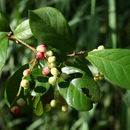Derivation of specific name
provided by Flora of Zimbabwe
venosum: veined, referring to the prominent veins
- license
- cc-by-nc
- copyright
- Mark Hyde, Bart Wursten and Petra Ballings
- bibliographic citation
- Hyde, M.A., Wursten, B.T. and Ballings, P. (2002-2014). Antidesma venosum E. Mey. ex Tul. Flora of Zimbabwe website. Accessed 28 August 2014 at http://www.zimbabweflora.co.zw/speciesdata/species.php?species_id=134560
- author
- Mark Hyde
- author
- Bart Wursten
- author
- Petra Ballings
Description
provided by Flora of Zimbabwe
Shrub or small tree. Leaves alternate, oblong to elliptic, leathery; veins sunken above, prominent below with hairs on the veins on both surfaces. Flowers in long catkin-like spikes, up to 8 cm; sexes on separate trees, male flowers yellow, female flowers reddish, unpleasantly scented. The flowers are often parasitised by insects to form a tangled mass of sterile galls. Fruits in pendulous spikes of small fleshy berries, red to purple-black when ripe, edible.
- license
- cc-by-nc
- copyright
- Mark Hyde, Bart Wursten and Petra Ballings
- bibliographic citation
- Hyde, M.A., Wursten, B.T. and Ballings, P. (2002-2014). Antidesma venosum E. Mey. ex Tul. Flora of Zimbabwe website. Accessed 28 August 2014 at http://www.zimbabweflora.co.zw/speciesdata/species.php?species_id=134560
- author
- Mark Hyde
- author
- Bart Wursten
- author
- Petra Ballings
Frequency
provided by Flora of Zimbabwe
Common
- license
- cc-by-nc
- copyright
- Mark Hyde, Bart Wursten and Petra Ballings
- bibliographic citation
- Hyde, M.A., Wursten, B.T. and Ballings, P. (2002-2014). Antidesma venosum E. Mey. ex Tul. Flora of Zimbabwe website. Accessed 28 August 2014 at http://www.zimbabweflora.co.zw/speciesdata/species.php?species_id=134560
- author
- Mark Hyde
- author
- Bart Wursten
- author
- Petra Ballings
Worldwide distribution
provided by Flora of Zimbabwe
Throughout Subsaharan Africa as far as Eastern Cape, South Africa.
- license
- cc-by-nc
- copyright
- Mark Hyde, Bart Wursten and Petra Ballings
- bibliographic citation
- Hyde, M.A., Wursten, B.T. and Ballings, P. (2002-2014). Antidesma venosum E. Mey. ex Tul. Flora of Zimbabwe website. Accessed 28 August 2014 at http://www.zimbabweflora.co.zw/speciesdata/species.php?species_id=134560
- author
- Mark Hyde
- author
- Bart Wursten
- author
- Petra Ballings
Antidesma venosum: Brief Summary
provided by wikipedia EN
Antidesma venosum, commonly known as the tassel-berry, is a species of small dioecious tree in the family Phyllanthaceae. It is native to Africa, China and Indochina.
Numerous small, sessile flowers are produced on drooping catkin-like spikes, which are about 10 cm long. The flowers produce an unpleasant smell, and the tree is in fruit for more than a month during late summer. Each small, oval-shaped fruit measures about 8 x 4 mm in size. They are initially fleshy green, and change to bright red and eventually purplish black as they ripen. The fruit are utilized by many species of animal and bird.
- license
- cc-by-sa-3.0
- copyright
- Wikipedia authors and editors

